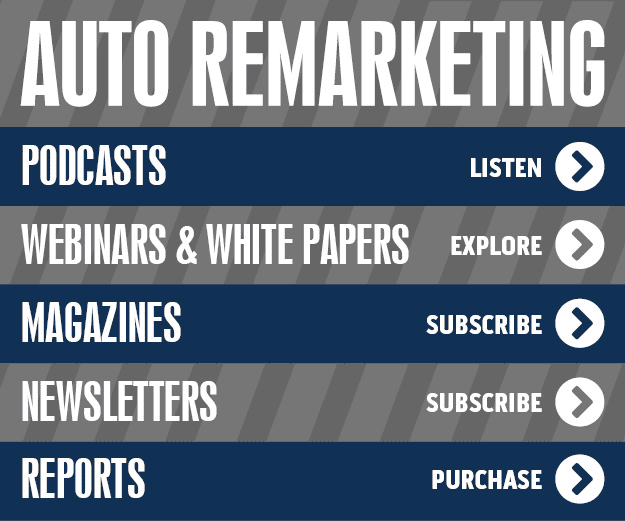The stream of developments from RouteOne continued on Tuesday as the company expanded its partnership with Southeast Toyota Finance, the provider of automotive financing for 176 Toyota dealers in the southeastern United States.
The expansion includes eContracting on RouteOne’s automotive finance platform.
RouteOne highlighted that its eContract volume has now exceeded 5 million funded deals since the inception. The company pointed out this momentum continues to accelerate as finance sources such as Southeast Toyota Finance have elected to implement RouteOne eContracting.
“Our No. 1 business goal is to help our Toyota dealer partners achieve success,” said Joanna Sherry, vice president of sales and marketing at Southeast Toyota Finance.
“eContracting is an initiative that will position our dealers to streamline the contract process and produce faster funding. It will deliver a superior experience to both our dealers and Toyota customers,” Sherry continued in a news release.
RouteOne continues to invest in enhancements to its eContracting platform to provide dealers the optimal technology solutions to sell and finance vehicles. The most recent enhancements to the RouteOne eContracting platform include electronic signature capture on mobile devices, the ability to switch associated credit applications, and self-service ability for dealers to convert eContracts to paper when necessary. RouteOne is committed to offering the best, most transparent experience possible to dealers in a market with evolving demands.
“We have a shared commitment to customer service and making it easier for dealers to sell and finance vehicles,” RouteOne chief executive officer Justin Oesterle said in a news release. “RouteOne eContracting improves the customer experience by reducing errors, ensuring all required signatures are captured, and validating deal data — all of which can contribute to faster funding for dealers.
“Through these and other efficiencies, RouteOne eContracting delivers a positive impact for dealers, customers and finance sources,” added Oesterle, who became the leader of RouteOne earlier this month before the company finalized other members of its leadership team.
GWC Warranty, the used vehicle service contract and related finance and insurance products provider for dealers, recently announced an expansion of its product set.
Highlighting the changes to GWC’s product set are upgraded terms for exclusionary coverage levels. GWC is now offering exclusionary coverage on vehicles with starting mileage as high as 150,000 miles.
Additionally, GWC is introducing new exclusionary terms of three and six months to provide dealers with even more options for providing a higher quality of coverage that is geared to rival a manufacturer’s factory warranty.
In addition to the improvements to GWC’s exclusionary offering are upgraded terms for select stated component plans. Now, stated component coverage is available on vehicles with starting mileage as high as 200,000 miles. This new mileage eligibility is complemented by stated component term lengths of three and six months — all designed with flexibility in mind to meet the diverse needs GWC’s dealers and their customers.
Now, GWC dealers can log in to the GWC Dealer Portal to view the new mileage eligibility and term lengths available to them as well as pricing for these newly added plans.
“At GWC, we understand that our dealers are a diverse group with a vast array of product needs suited to their individual businesses,” GWC chief executive officer and president Rob Glander said. “These changes add to our already expansive and flexible product set while giving dealers more options to choose from when creating a service contract program that is tailored to their specific business needs.”
Rounding out the newest member of its leadership contingent, RouteOne’s board of directors on Thursday appointed Chris Irving as its chief technology officer in the latest move with new chief executive officer Justin Oesterle at the controls of the platform designed to deliver a comprehensive suite of F&I solutions.
Irving has spent eight years with RouteOne and served as its director of application development and director of IT operations. RouteOne indicated Irving will now assume the prior responsibilities for managing all information technology and systems development, which were formerly overseen by Oesterle.
Irving will join RouteOne’s executive team, effective immediately, helping build upon its strong strategic and operating foundation. Led by Oesterle, the executive team will now consist of:
• Janice Basile, chief financial officer, responsible for all accounting and financial matters
• Daniel Doman, chief legal and privacy officer, responsible for all legal matters, security, internal audit and governmental affairs
• Irving, chief technology officer, responsible for managing all information technology and systems development
• Todd Mason, chief strategy officer, responsible for managing product conception, development and strategy, as well as all marketing-related strategy and tactics
• Brad Rogers, chief operating officer, responsible for managing all sales, customer strategy, integrations and customer support services
Prior to joining RouteOne, Irving was responsible for information technology across the automotive and financial services industries, including information technology manager at Brembo S.p.A., NAO operations support manager at GMAC Financial Services, and senior operations manager, information technology at Kaplan Financial.
Irving also spent time as a consultant for General Motors, focused on operations, process improvement and governance.
Irving earned a master's of business administration from Walsh College and his bachelor of science from Michigan State University, and graduated from the Electronic Data Systems (EDS) Information Analyst Development Program.
On Tuesday, SouthWest Dealer Services — an independent full-service provider of F&I products and services to dealers — announced that SWDS Holdings’ board of directors appointed Vernon Leake as chief executive officer. Leake succeeds Eric Hamann, who will now serve as president of SouthWest Dealer Services.
“Vernon and I have worked together for several years. He is an exceptional leader and has the skill set needed to lead the company as we continue to grow SouthWest, both organically and through strategic acquisitions,” said Ken Shubin Stein, CEO and chairman of Spencer Capital Holdings, parent company of SWDS.
Leake recently served as SWDS’ senior vice president of reinsurance and as a managing director at Spencer Capital Holdings. Prior to joining SWDS, he was CEO and co-founder of Century Automotive Service Corp.
Subsequent to the MAPFRE Group’s acquisition of Century in 2012, Leake served as its CEO and head of specialty risk for North America. In the earlier part of his career, he was an officer and member of the board of directors of DAC Insurance Co.
“I am honored and excited to take on this role and work with the leadership team at SouthWest and at Spencer Capital to take advantage of the tremendous market opportunity and continue growing our footprint, while providing best-in-class service to our dealer partners,” Leake said.
Founded in 1987, the company that focuses on providing dealers with auto security products, vehicle service contracts, guaranteed asset protection (GAP) programs and other ancillary F&I products has regional offices in:
—Arizona
—California
—Colorado
—Idaho
—Illinois
—Indiana
—Iowa
—Kansas
—Missouri
—Nevada
—New Mexico
—Oklahoma
—Oregon
—Texas
—Washington
—Wyoming
White Clarke Group acknowledged that it seemed like just a few months ago that experts thought auto finance companies would inevitably lose their businesses to technology-savvy new players entering the market as disruptors.
The company predicted these new entrants would focus hard on customer needs, understand where the weaknesses are in existing sales models, and use their techy skills to better serve auto finance customers and thereby outcompete the more traditional, slow-moving market incumbents.
At this May’s International Auto Finance Network conference in London, however, White Clarke Group highlighted that attendees were given a glimpse of a potentially different outcome — one in which tiny fintech start-ups and mighty manufacturer captives could work together to solve problems on the road to a digital auto finance future.
Jonny Combe, product and channel development manager at BMW Financial Services, told conference attendees how the captive has teamed up with corporate innovation specialist and investment fund managers L Marks to identify early stage growth companies they can bring into innovation labs and accelerators to develop innovative solutions to opportunities and problems the company faces on its journey to digitalization.
At the end of the 10-week innovation lab process, the winning start-up will win the opportunity to pilot its solution with BMW, as well as gaining investment from both L Marks and BMW.
“It is not hard to see the attraction to fintech entrepreneurs of winning the support of a large organization like BMW — particularly as their world becomes ever more crowded and competition for funding becomes increasingly intense,” White Clarke Group said.
“What is interesting, however, is that BMW sees innovation labs as a part of a larger cultural transformation which they (and by extension all captives) need to make in order to dominate digital real estate in tomorrow’s auto finance world,” the firm continued.
White Clarke Group pointed out that employees in large organizations tend to think alike, and to recruit those with the same characteristics. Combe argued that this leaves the business vulnerable — particularly at times like now when the industry is facing rapid change, and the need to develop new core competencies.
“Innovation labs would seem to offer a way for fintech and captives to learn from each other, bringing increased diversity and entrepreneurial innovation into the very heart of BMW — rather than leaving it outside, as one would in a more normal traditional supplier-customer relationship — helping BMW to build solutions faster, and to absorb some of the innovative new skills of their start-up partners,” White Clarke Group said.
If successful, White Clarke Group insisted the results could be interesting.
“This is an imaginative and interesting solution to a critical industry challenge, and one which, in our opinion, deserves to succeed,” White Clarke Group officials said.
Combe’s conference presentation can be seen in the window at the top of this page or by going here.
In order to make indirect auto financing seamless, CRIF Lending Solutions and Dealertrack are joining forces.
CRIF Lending Solutions recently announced a partnership with Dealertrack, a Cox Automotive brand, to integrate its CRIF ACTion loan origination system with Dealertrack’s e-contracting software. The companies hope to improve both the efficiency of their software and the portfolio growth of their finance companies with this move.
“This partnership will allow our clients to significantly increase their paperless volumes, which makes this much more convenient for the customer, dealership and financial institution,” Kyle Kehoe, president of the CRIF ACTion division, said in a news release. “It also serves as the latest example of how the ACTion team remains committed to leveraging leading-edge technology to help our clients achieve even greater success.”
While the CRIF ACTion platform can confirm, process and fund loans automatically through their online and mobile software, the inclusion of Dealertrack’s e-contracting system make the signing of the documents, one of the few manual parts of the process, even faster. The system draws up contracts with the specific information and allows dealers and their customers to review and sign the contracts on tablet devices, which can push immediately through the CRIF origination system.
Mark Furcolo, senior vice president of lender solutions at Dealertrack, said that the partnership “will help dealers and lenders capitalize on digital technologies, such as e-contracting, to transform their businesses and dramatically improve their customers’ car buying experience.”
Mark Sargeant insisted banks and other capital providers are interested in the tool AUTOMAP Tracking Solutions offers: a product that can reduce the time it takes to complete an audit to minutes instead of days while mitigating risk.
Here’s boiler plate of what AUTOMAP can do: A device is inserted into the on-board diagnostics (OBD) port inside the vehicle. Through Bluetooth technology when dealership staff members have an app running on their smartphone, information about the vehicle, including location, odometer reading and more, can be uploaded to a cloud server. Authorized users from a finance company can review details about all the vehicles in store inventory that are connected with that floor plan through data updated each time someone walks the lot.
“If a dealership goes bankrupt, 80 percent of the loss is the loss of the vehicle,” said Sargeant, AUTOMAP’s sales and marketing manager. “If we can take that 80 percent loss to a lender and eliminate it, that’s huge.”
Sargeant pointed out that AUTOMAP’s devices are different than GPS-driven solutions finance companies often leverage when booking contracts with deep subprime customers. The OBD device needs to communicate with the smartphone app, but Sargeant insisted the tool can differentiate between the vehicle and a spoofing devices because AUTOMAP spent nearly three years in development.
“We had to start from scratch,” Sargeant said. “Security has been very tight, and that’s why we built this from the ground up with security in mind.
“There’s no way to spoof the system, either,” he continued. “You can go online and buy an emulator for $150; something that pretends it’s a car. You can program it to simulate fuel levels to acceleration, even the VIN. Our device can detect whether it’s coming from an emulator or a car with an actual heartbeat. There’s no going around and spoofing the system to pretend it’s in a car when it’s really not.”
AUTOMAP didn’t start to market its product until earlier this year. So far, a trio of pilot programs are underway with a handful of dealerships and finance companies. But the company is in discussions with a host of other institutions as well as audit providers and wholesale auctions about how its tool can streamline the process, eliminate the potential for fraud as well as mitigate risk.
“We’ve been involved in vehicle tracking for 10 years,” Sargeant said. “We consider ourselves a hardware company.”
“With our product, the large banks are very interested in it, especially in large dealerships where it takes days to do an audit,” he continued. “The high-risk lenders who are doing business with the smaller dealerships, they just want to keep track of where the vehicles are and make sure that collateral is still there.”
More details about the product can be found at the company’s website or by viewing the video at the top of this page or here.
With the May employment report from the Bureau of Labor Statistics landing with “a thud,” according to the reaction by Comerica Bank chief economist Robert Dye, the auto finance industry likely will have to wait until later this summer at the earliest for the Federal Reserve to make a move regarding interest rates.
To recap, the BLS reported only 38,000 net new payroll jobs were added to the U.S. economy in May. Dye called the figure “well below expectations.”
He continued in Comerica’s latest Economist Update that “this could turn out to be an anomalous report, and it is reasonable to expect some bounce back in the June labor data, due out July 8. However, there is enough corroboration outside the June employment report to take the miss seriously.”
Dye first mentioned that job growth in the ADP employment report has been trending down.
“We have been expecting a similar downtrend in the official BLS data,” he said. “We could be seeing the start of a downtrend with the last two months of payroll data, when April saw a gain of just 123,000 jobs, followed by May’s very weak 38,000.
Furthermore, Dye pointed out that productivity growth has been very weak as recent soft productivity growth has been an important debate topic amongst economists. University of Chicago economist Robert Gordon recently published a book focusing on productivity.
Comerica indicated U.S. productivity growth was just 0.6 percent in the first quarter versus the same period a year earlier.
Also, Dye noted that both the May ISM Manufacturing Index and the May ISM Non-Manufacturing Index showed employment sub-indexes below 50, indicating a contraction in employment for the month.
“Timing is everything. The weak May employment report, released just 10 days before the upcoming Federal Open Market Committee meeting, over June 14 and 15, will likely keep an interest rate increase on hold,” Dye said.
“We still think that a fed funds rate increase for July 27 is on the table. But the economic data will need to be solid in front of that meeting,” he continued.
What the Fed is saying
Earlier this week, Federal Reserve chair Janet Yellen discussed her view of current U.S. economic conditions during a speech at the World Affairs Council of Philadelphia. Yellen acknowledged the latest employment report left the Fed with a difficult decision.
“So the overall labor market situation has been quite positive,” said Yellen, who mentioned that the economy added 2.7 million jobs last year for an average of 230,000 a month.
“In that context, this past Friday’s labor market report was disappointing,” she continued. “An encouraging aspect of the report, however, was that average hourly earnings for all employees in the nonfarm private sector increased 2½ percent over the past 12 months — a bit faster than in recent years and a welcome indication that wage growth may finally be picking up.”
Yellen’s prepared remarks — available online on the Fed’s website — touched on a host of other economic matters such as inflation and GDP, with the Fed taking an overall stable stance on what might be ahead. She closed by reiterating that the Fed is considering all angles before making decisions regarding interest rates.
“My colleagues and I will make our policy decisions based on what incoming information implies for the economic outlook and the risks to that outlook,” Yellen said. “What is certain is that monetary policy is not on a preset course, and that the committee will respond to new data and reassess risks so as to best achieve our goals.”
Another Fed commentary about its latest report on household economic well-being can be viewed in the window at the top of this page or by going here.
Impact on auto finance
During a webinar hosted by the Consumer Bankers Association ahead of Yellen’s remarks and the latest employment update, Moody’s Analytics senior director Cristian deRitis reiterated how much employment and interest rates play a role in vehicle sales and the possibility for originations.
“The labor market is very essential to the auto sales and auto credit industry. If the labor market is not performing or if jobs are not being added to the economy, that will impact our outlook. We anticipate some wage growth,” deRitis said.
And with regard to an uptick in interest rates, deRitis is expecting the Fed to be “moving at a relatively slow pace, allowing time for the market and for individuals to adjust to those rates.
“But there is a risk that if interest rates were to rise very sharply, that would certainly put a damper on vehicle sales,” he added.
Commercial banks and credit unions typically work with customers in the prime space, but recent analysis shared by Equifax and Moody’s Analytics was geared to give executives and managers with those institutions some evidence in order to consider borrowers who might fall in the non-prime or even subprime tiers.
Before going into a series of charts and graphs during a recent webinar hosted by the Consumer Bankers Association, Equifax auto finance leader Lou Loquasto emphasized how a healthy mix is important for any part of the credit market, especially automotive.
“If our industry makes all of the loans at 800 credit, losses are going to be super low. But if they make them all at 500 credit, losses are going to be super high,” Loquasto said.
“If you look at the mix over the past five years, we have been really steady since 2011,” he continued. “What that tells us — because auto loans are short term and losses, when they come, may come sooner rather than later in the loan term — we at Equifax expect the future performance of the recent pools of business to look very similar to what happened in 2014 and 2015. That’s one of the reasons we’re very optimistic about where we’re going.”
Loquasto highlighted how much banks and credit unions have grown their auto portfolios already, noting how these institutions had about 32 percent of the entire market back in 2006. But thanks to the overall auto industry surge between 2010 and 2015, Equifax pinpointed that share at nearly 46 percent.
“The segments that know their customers most intimately — banks and credit unions; segments that most people consider to be the most conservative — they’ve held a very steady market share since 2010. We view that as a very healthy sign,” Loquasto said.
The Equifax expert acknowledged concerns banks and credit unions in particular might have about the additional risk now baked into auto finance nowadays since terms are lengthening and outstanding balances are growing.
“When things are getting written about subprime, loan size or terms, that can trigger concerns that our lenders have to respond to — whether it’s concerns from senior management, regulators or others,” Loquasto said. “As it relates to loan size, cars are more expensive now. The loan sizes are going to be higher. But they’re being built much better than in the past so there’s less risk of a vehicle breaking down and causing very expense repairs or a customer to walk away. There’s also less need to trade up or upgrade quickly. Ten years ago a customer might be in a vehicle thinking in a year or two I’ll go ahead and get the car I really wanted. With the loan sizes going up, those cars have more features.
“We expect the duration of those loans to continue to increase. That’s a good thing for lenders and lender profitability,” he continued.
“At Equifax, we do believe that there is a great opportunity for banks and credit unions in particular to better serve their near-prime and non-prime customers. For subprime, there’s not a ton of lending being done by the banks and credit unions, but the lending that is being done has very low losses, representing a great opportunity going forward,” Loquasto went on to say.
Part of why Loquasto emphasized why banks and credit unions should consider being prudent when buying deeper down the credit spectrum is something both he and fellow webinar presenter Cristian deRitis touched on: Vehicle sales are about to slow. It’s what deRitis, the senior director at Moody’s Analytics, described as the difference between “pent-up demand” and “spent-up demand.”
Because of an anticipation that interest rates will rise later this year and into next year, deRitis said, “that will slow volume somewhat as buyers who may be taking advantage of the cheap financing today decide in the future either to pay cash or to use other financing vehicles such as home equity to finance their transactions. There are some other factors that are going to drive demand as well: pent-up demand, or really the exhaustion of pent-up demand.
“Prior to the recession, we had sales volume in excess of what the trend would say,” he continued. “From a period of around 2000 until 2008, we would have classified this excess as a period of spent-up demand; essentially, consumers were buying too many vehicles or more vehicles that needed to keep up with equilibrium and pulling sales forward.
“Then we had the recession, which certainly created a collapse in new-vehicle sales,” deRitis went on to say. “It gave us some time to work off some of that spent-up demand, so from about 2008 until 2011, we worked off much of that excess spending, those pulled forward type of vehicle sales. At that point we started to accumulate pent-up demand, we were still well below the equilibrium level of sales.
“Based on the analysis, even today, we’re in a period of pent-up demand. There’s still buyers out there that put off purchase of a vehicle during the recession and recovery period that still want a vehicle. They’re still going to fuel vehicle sales in the short term,” he added.
Closing the thought, deRitis shared that Moody’s projects that level of equilibrium sales to be about 16.5 million to 17 million new vehicles, a figure the firm expects the market to generate through 2018.
Later during his portion of the webinar, Loquasto added, “If lenders want to continue healthy growth rates, lenders are not going to be able to rely on increasing car sales and pent-up demand. They’re going to have to look to tweak their strategies — banks in particular.”
RouteOne moved within a month to pick a new chief executive officer, elevating one of its executives who has been with the company since its inception.
RouteOne’s board of directors named Justin Oesterle as CEO, insisting that he will continue to execute the company’s focused mission of providing systems and services of choice to dealers and finance sources in the vehicle financing industry.
The company highlighted Oesterle is well positioned in his ability to execute the RouteOne vision and strategy. He has been with the organization since its beginnings in 2002 and has served in numerous executive leadership positions including chief information officer, vice president of sales, marketing and strategic alliances as well as vice president of operations and program management.
In this time period, RouteOne experienced significant growth, building an industry-leading network of dealers and finance sources active in the credit, eContracting and point-of-sale space. RouteOne’s network also includes more than 125 integration partners, allowing dealers to choose the systems that best fit their strategic plans and sales processes.
Oesterle plans to build upon the strong foundation established by former CEO Mike Jurecki and maintain its positive work culture that earned the company honors of the Detroit Free Press Top 100 Workplaces award in 2015.
Jurecki left RouteOne in mid-May to become CEO of Ford Direct.
“I am pleased to take on the CEO responsibilities with which our board of directors has entrusted me,” Oesterle said. “RouteOne is very fortunate to be on excellent strategic and operational footing thanks to Mike Jurecki’s leadership, an outstanding team of leaders, and the support of our owners.
“I look forward to continuing RouteOne’s service to our customers and meeting their needs as the marketplace rapidly evolves,” Oesterle continued.
Oesterle will also serve as chairman and CEO of RouteOne Canada.
Prior to joining RouteOne, Oesterle was a senior manager with Deloitte Consulting, focused on captive finance organizations.
Oesterle earned an MBA with concentrations in finance and strategy from the University of Michigan as well as a bachelor’s degree in economics from the same school.












